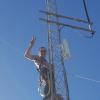Hello all,
I am with the K7MSH Utah Amature Radio Mesh club in Central Utah. We currently have 3 mountaintop nodes with M2 Rocket/Sectors at each site. The only thing linking them are users in the valley that can see at least 2 of the mountaintop nodes. The question I have is if it's conducive to have them linked with 3 or 5 ghz. My understanding is that by isolating the two mountains with another band will help with the hidden node and packet collision/retry issues.
Does anyone have any information to why it would or would not matter to separate them by linking with another band?
I am with the K7MSH Utah Amature Radio Mesh club in Central Utah. We currently have 3 mountaintop nodes with M2 Rocket/Sectors at each site. The only thing linking them are users in the valley that can see at least 2 of the mountaintop nodes. The question I have is if it's conducive to have them linked with 3 or 5 ghz. My understanding is that by isolating the two mountains with another band will help with the hidden node and packet collision/retry issues.
Does anyone have any information to why it would or would not matter to separate them by linking with another band?


I use AREDN for my backhauls, but some guys will use airOS. There are a couple of threads on the forum discussing the pros and cons...search for backhaul.
Assuming everything else is the same (links are equal quality, equal amounts of competing stations etc) you can double the network speed with a seperate band hop (just like in the old packet days, a a node that has to transmit on the same frequency it receives on has 50% speed)
In reality you probably won't have these equal conditions and being able to pull off to a seperate band means that in addition you also get chances for less competition to the frequency, possibly tighter controlled distance parameter settings (which impacts speed) , ideally higher SNR (because of the ability to use directed aimed antennas), and the list goes on.
Ideally you will still have connections at the lower levels or backhaul levels for redundancy, these links will usually not be the greatest but can still be auxiliary paths.
Has a path link profile been completed? I also see two of them from AD7QF-QTH2, alibet with poor links, seeing them on a side node. Antelope has a 3 and 5 gHz node, with the 5 aimed south. With my clear path to Nelson and Lake Mountian, I could point my QTH3 south.or set up a 5.
But the comment is, check for a clear path between the mountain top nodes.
Correct, including the fact that backoff timers are used as well for collisions.
I was in charge of a full duplex packet repeater here for a while, and most people never heard of such a think so glad to hear someone else who knows of it (though ours was a standard 2m with 600kHz split :)
While the implementation is very different for mesh, a lot of the old packet knowledge (in my mind at least) holds true on mesh. I'll often analogy to packet like this to make it easier to explain to people.